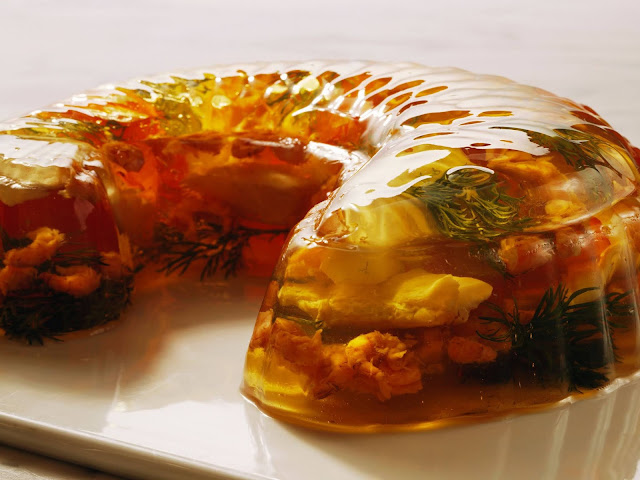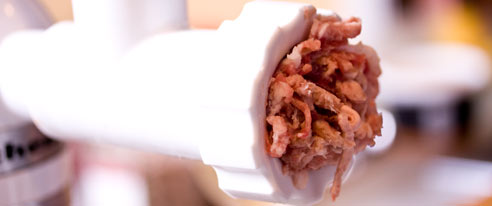Aspic
Aspic
Aspic is a dish in which ingredients
are set into a gelatin made from a meat stock or consomme. Aspic can also be referred to as aspic gelée or aspic
jelly. Non-savoury, sweet dishes, often made with commercial gelatin mixes
without stock or consommé, are usually called jello salads in the United States, or gelatin
salads elsewhere.
History
The 10th century Kitab al- Tabikh, the
earliest known Arabic Cookbook, contains
a recipe for a fish aspic called qaris. It was made by boiling
several large fish heads with vinegar, parsley, cassia, whole onions, rue, black pepper, ginger, spikenard, galangal, clove, coriander seeds and long pepper. It is colored with saffron enough to add a
"radiant red". The cooked fish heads were removed from the vinegar
cooking liquid along with the seasonings, and only the tongues and lips were
returned to steep in the liquid until it cooled and gelatinized. According to
one poetic reference by Ibrahim ibn al-Mahdi describing
a version of the dish prepared with Iraqi carp it
was "like ruby on the platter, set in a pearl... steeped in saffron thus,
like garnet it looks, vibrantly red, shimmering on silver."
Historically, meat aspics were made before fruit- and
vegetable-flavored aspics. By the Middle Ages at the latest, cooks had discovered that a
thickened meat broth could be made into a jelly. A detailed recipe for aspic is
found in Le Viandier, written
in or around 1375.
In the early 19th century, Marie - Antoine Careme created chaud
froid in France. Chaud froid means "hot
cold" in French, referring to foods that were prepared hot and served
cold. Aspic was used as a chaud froid sauce in many cold fish
and poultry meals. The sauce added moisture and flavor to the food. Carême
invented various types of aspic and ways of preparing it. Aspic, when used
to hold meats, prevents them from becoming spoiled. The gelatin keeps out air and bacteria, keeping the cooked meat fresh.
Aspic came into prominence in America in the early 20th
century. By the 1950s, meat aspic was a popular dinner staple throughout the
United Statesa as were other gelatin-based dishes such as tomato aspic. Cooks
used to show off aesthetic skills by creating inventive aspics.
Culinary
preparation
When cooled, stock that is made from meat congeals because
of the natural gelatin found in the meat. The stock can be clarified with egg whites, and then filled and flavored just before the aspic
sets. Almost any type of food can be set into aspics. Most common are meat
pieces, fruits, or vegetables. Aspics are usually served on cold plates so that
the gel will not melt before being eaten. A meat jelly that includes cream is
called a chaud-froid.
Almost any meat (poultry or fish included) can be used to
make gelatin. The aspic may need additional gelatin in order to set properly.
Veal stock (in particular, stock from a boiled calf's foot provides a great deal of gelatin; in making stock, veal is often included with
other meat for that reason. Fish consommés usually have too little natural
gelatin, so the fish stock may be double-cooked or supplemented. Since fish
gelatin melts at a lower temperature than gelatins of other meats, fish aspic
is more delicate and melts more readily in the mouth.
Fish stocks usually need added gelatin to maintain a molded
shape. Vegetables have no natural gelatin.
Culinary
uses
Aspic jelly may be colorless (white aspic) or contain
various shades of amber. Aspic can be used to protect food from the air, to
give food more flavor, or as a decoration.
There are three types of aspic: delicate, sliceable, and
inedible. The delicate aspic is soft. The sliceable aspic must be made in
a terrine or in an
aspic mold. It is firmer than the delicate aspic. The inedible aspic is never
for consumption. It is usually for decoration. Aspic is often used to glaze
food pieces in food competitions to make the food glisten and make it more
appealing to the eye. Foods dipped in aspic have a lacquered finish for a fancy
presentation. Aspic can be cut into various shapes and be used as a
garnish for deli meats or pâtés.






Comments
Post a Comment